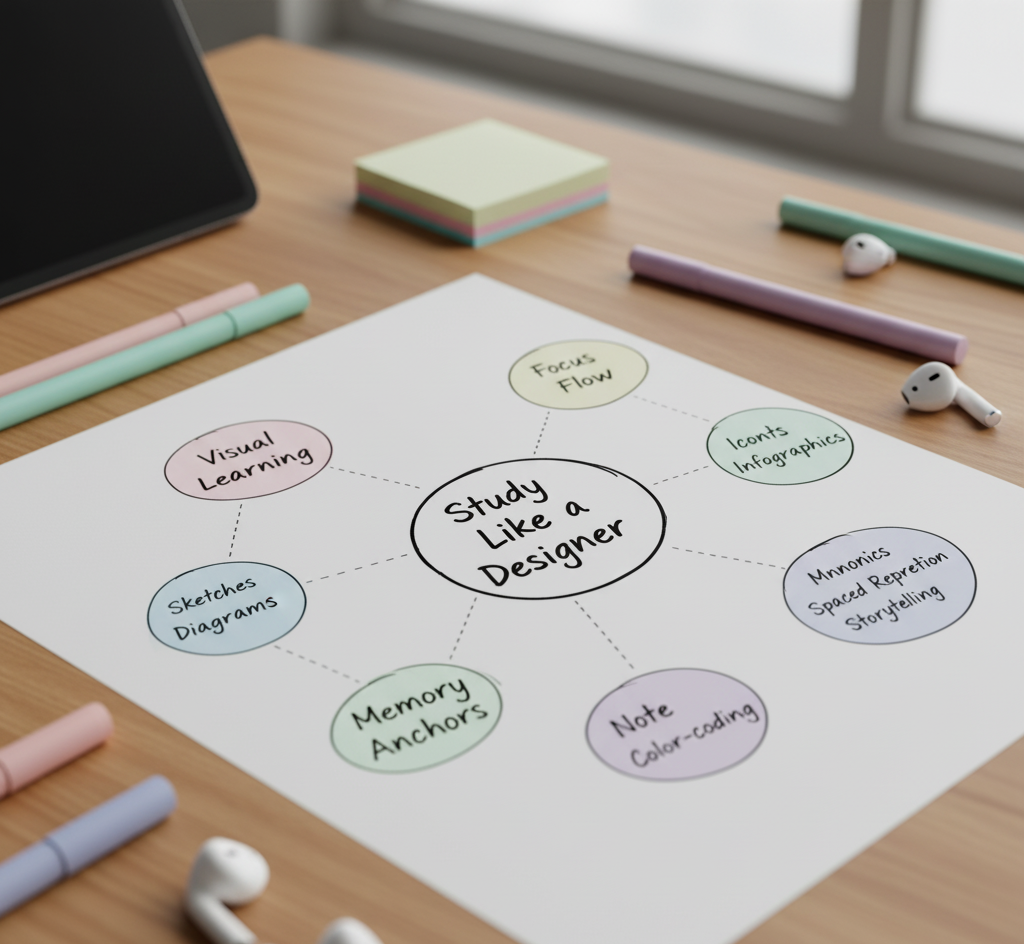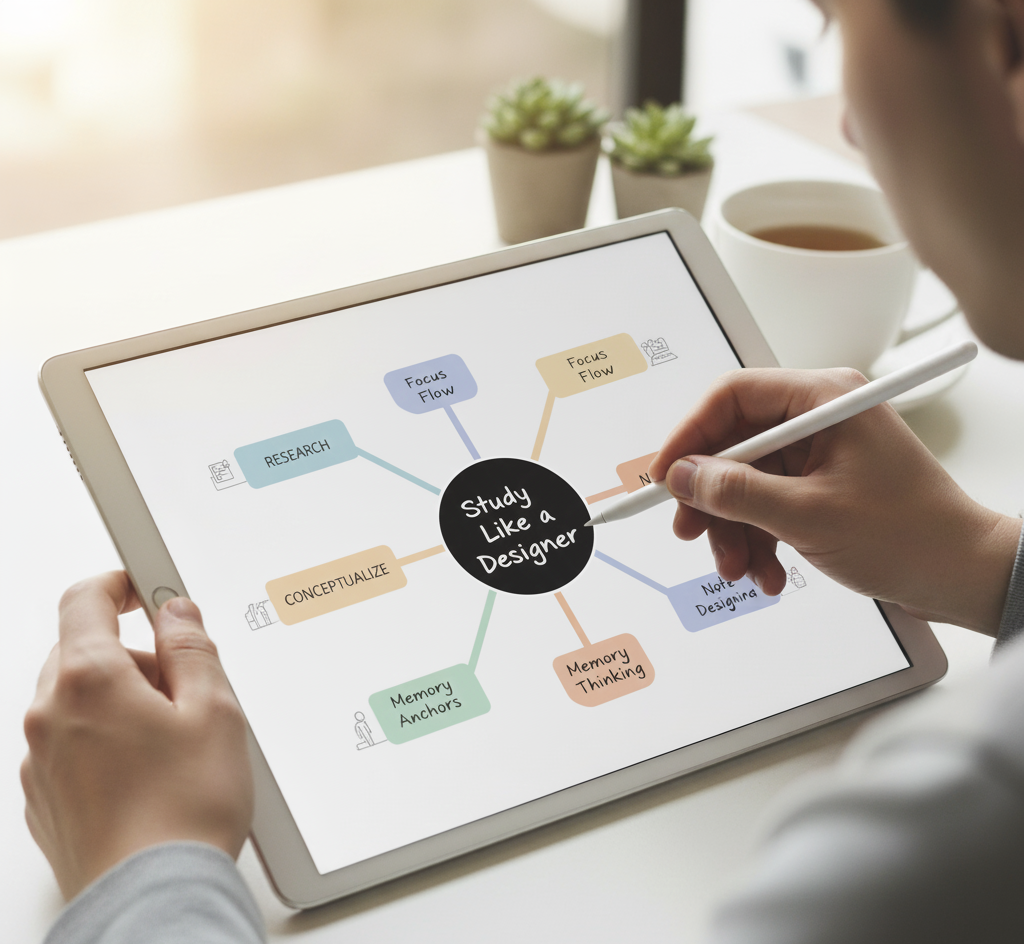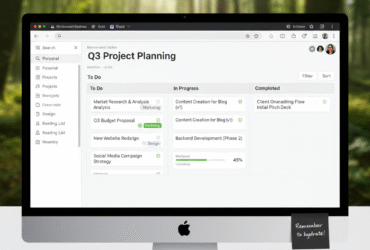Have you ever sat in front of your notes feeling like your brain is just… full, but not organized? You’ve gathered tons of information—yet connecting it all feels like herding cats. That’s where mind mapping changes everything.
Mind maps are a visual way to study and think—something designers and creatives have relied on for decades to make complex ideas simple. Unlike traditional note-taking, mind maps help you see how everything connects.
If you read my previous article, Study Methods for Adults (link to your previous post), you already know that effective learning isn’t about working harder—it’s about studying smarter. Today, we’ll take that one step further with a creative approach that helps you learn like a designer: the mind map study method.
By the end of this post, you’ll know exactly how to use mind maps to study efficiently, boost memory, and bring more flow and clarity to your learning process.
What Exactly Is a Mind Map?
A mind map is a visual diagram that starts with a single idea in the center and branches out into related topics. It’s basically your thoughts on paper—organized like a tree instead of a list.
Instead of rigid outlines, mind maps mirror how your brain naturally works: associatively and visually. Designers use them for brainstorming; learners can use them to connect ideas, structure projects, or review notes.
Here’s how it works:
- Start with your main topic in the center.
- Add branches for key ideas or subtopics.
- Expand each branch with smaller details or examples.
- Use visuals or colors to make connections clearer.
Key takeaway: Mind maps turn messy thoughts into meaningful structure.
Why the Mind Map Study Method Works

So, why does this method fit so well for adults? Because as professionals and lifelong learners, we often deal with conceptual overload. Mind maps combat that by externalizing thought.
1. Visual Learning Boosts Retention
Our brains process visuals faster than text—about 60,000 times faster, according to studies. Mind maps use that to your advantage.
When you pair color, shape, and spatial layout with words, memory pathways strengthen naturally. You’re not just memorizing—you’re building context.
2. It Reduces Overwhelm
When I first started using mind maps for my online courses, I noticed something unexpected: I felt calmer. Seeing my thoughts visually made large projects feel manageable again.
Key takeaway: Mind maps give your ideas space to breathe.
3. It Sparks Creativity
Linear notes can make learning feel mechanical. Mind maps, on the other hand, mimic creative thinking. They invite playfulness—color-coding, doodling, rearranging connections—all while reinforcing understanding.
How to Create a Mind Map (Step-by-Step)

You don’t need artistic skills to do this. Just a blank page—or your favorite digital tool.
Step 1: Choose Your Central Idea
Write your main topic in the center. For example, “Neuroscience Basics” or “Design Principles.”
Step 2: Create Major Branches
Add 3–5 big branches for the main themes. Example: “Memory,” “Focus,” “Neurons,” “Sleep.”
Step 3: Add Sub-Branches
Under each main idea, jot smaller details or keywords. Keep it short—just triggers for memory, not full sentences.
Step 4: Use Colors and Icons
Designers use visuals for a reason—color helps the brain categorize. Use one color per branch or add small icons for visual cues.
Step 5: Review and Revise
Revisit your mind map later. Add new links, rearrange nodes, or highlight key patterns. The goal is to see understanding evolve.
Key takeaway: Your first mind map is a draft, not a destination. It grows with your understanding.
Recommended Tools for Digital Mind Mapping

If you prefer digital organization, several intuitive tools make this process smooth:
- MindMeister – Beautiful and intuitive; perfect for visual thinkers.
- Notion – Use free templates or embed visual mind maps for integrated studying.
- Miro – Ideal for collaborative mapping and creative brainstorming.
- XMind – Clean interface, great for personal learning maps.
When to Use Mind Maps in Your Study Process
Mind maps aren’t just for brainstorming—they can fit anywhere in your learning cycle:
- Before studying: Plan what to learn and why it matters.
- During studying: Connect new ideas visually to what you already know.
- After studying: Summarize key points to strengthen memory.
You can even create a “chapter map” for each subject. One glance gives you a full overview—no endless scrolling through notes.
Key takeaway: Mind maps are flexible companions—use them to plan, learn, or review.
Common Mistakes to Avoid
- Overcomplicating the design.
Keep it simple—if you spend more time styling than thinking, it’s decoration, not learning. - Writing full sentences.
Use short keywords to trigger recall. - Skipping color or visuals.
Without visual cues, it’s just another outline. - Never reviewing it.
The map’s power grows with reflection and updates.
Key takeaway: Mind mapping is about clarity, not perfection.
Conclusion

Mind maps offer a simple truth: learning is easier when you see your thoughts. They blend logic and creativity—the left and right brain finally shaking hands.
Next time you study, try sketching a mind map before you start reading. You’ll notice your focus sharpens, distractions fade, and ideas begin to connect naturally.
If you want to explore more learning frameworks designed for adult learners, check out my post on Study Methods for Adults. Together, these two approaches can reshape how you study—calmly, clearly, and with purpose.





